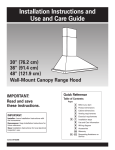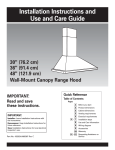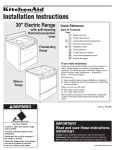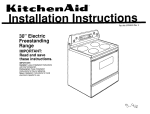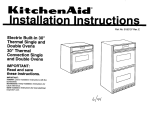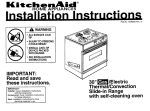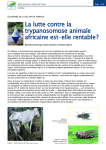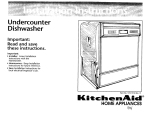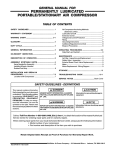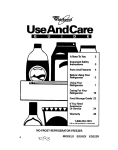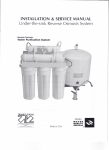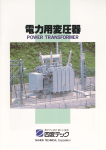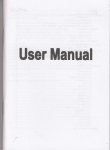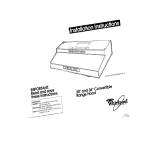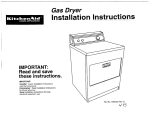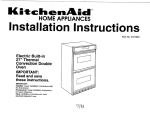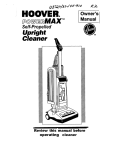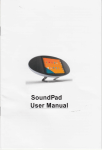Download KitchenAid 3184330 User's Manual
Transcript
Installation Instructions/Use and Care Guide Hot Water Dispenser Important: Read and save these instructions. IMPORTANT: Installer: Leave Installation Instructions with homeowner. Homeowner: Keep Installation Instructions for future reference. Save Installation Instructions for local electrical inspector’s use. Part No. 3184330 Before you start... Check location where hot water dispenser will be installed. Proper installation is your responsibility. Make sure you have everything necessary for correct installation. It is the responsibility of the installer to comply with installation specifications provided and with state and local plumbing codes. Electrical Shock Hazard Special care must be taken when drilling holes into walls or water pipes. Electrical wires may be concealed behind the wall covering or water may remain in pipes. Failure to follow this instruction could result in personal injury or death. Personal Injury Hazard Install faucet with lever to the side or behind spout. Failure to do so may result in hot water scalding hand when operating lever. Faucet mounting: requires a 1-l/l 6” to l-3/8” diameter opening in sink or countertop for mounting hot water dispenser faucet. Faucet can be installed in place of sink sprayer. For other installations, contact a qualified installer for best procedure to drill a hole through your type of sink or countertop. Thickness of sink or countertop hole must not exceed 3/4”. Dimensions NOTE: This hot water dispenser is Not a water purifier. Some installations may require a filter (such as charcoal) for increased satisfaction. shown must be used. Property/Product Damage Contact a qualified installer or licensed plumber for the best procedure for cutting a faucet opening in your type of sink or countertop. l Plumbing connections must comply with all sanitary, safety and plumbing codes. l Do Not store or operate hot water dispenser below 32°F. l Do Not use pipe sealing compounds. They may get inside dispenser and cause an unpleasant taste or smell. l Dispenser must be filled with water and thermostat turned to “OFF” position before connecting to electrical power supplyFailure to follow these instructions may result in water damage to property or permanent product damage not covered by the warranty. Proper cold water supply connection must be available. (See “Water supply requirements,” Panel B.) l Use saddle tapping valve supplied. Saddle tapping valve is designed for use with 3/8” to l3/8” outer dimension (O.D.), soft copper tubing (plain or chrome plated) or rigid metal pipe. Do Not use the saddle valve with flexible ribbed tubing. (See “Water supply requirements,” Panels B.) Flexible ribbed tubing requires special connecting hardware available from your local plumbing supply. Grounded electrical outlet is required. (See “Electrical requirements,” Panel B.) Outlet should be located for easy connection to hot water dispenser. The outlet should be within 30” of hot water dispenser tank. Top view Water connections use compression fittings which do Not require sealing compounds to keep them from leaking. lever install faucet with lever to the side or behind spout. Important: Observe all governing ordinances. codes and Faucet mounted in existing hc - )le in sink. sink or countertop hole Cold water line 30” max.-electrical outlet to hot water dispenser tank. Panel A .- spout Tools and materials needed for installation: Electrical Shock Hazard l Electrical ground is required on this appliance. l If cold water pipe is interrupted by plastic, non-metallic gaskets or other insulating materials, Do Not use for grounding. l Do Not ground to a gas pipe. l Do Not modify the power supply cord plug. If it does not fit the outlet, have a proper outlet installed by a qualified electrician. l Do Not have a fuse in the neutral or grounding circuit. A fuse in the neutral or grounding circuit could result in electrical shock l Do Not use an extension cord with this appliance. l Check with a qualified electrician if you are in doubt as to whether this appliance is properly grounded. Failure to follow these instructions could result in serious injury or death. tubing cutter bucket or pan 9/l 6”, 7/l 6” and Ii2 open-end wrenches If codes permit and a separate grounding wire is used, it is recommended that a qualified electrician determine that the grounding path is adequate. l/4” O.D. copper tubing 2 mounting bracket screws (and 2 plastic anchors if attaching to dry wall) pencil Parts supplied for installation: 4 saddle tank bracket For your personal safety, this appliance must be grounded. This appliance is equipped with a power supply cord having a 3-prong grounding plug. To minimize possible shock hazard, the cord must be plugged into a mating 3-prong groundingtype wall receptacle, grounded in accordance with National Electrical Code, ANSVNFPA 70-latest edition* and all local codes and ordinances. (See Figure 1.) If a mating wall receptacle is not available, it is the personal responsibility and obligation of the customer to have a properly grounded 3-prong wall receptacle installed by a qualified electrician. Copies of the standard listed may be obtained from: l National Fire Protection Batterymarch Park Quincy, Massachusetts 3-pron groun ci!mg-type wall receptacle , brass insert 8 -62 2 square nuts cord Figure 1 faucet assembly Remove parts from packages. parts were included. Panel B Water supply requirements Electrical requirements Check that all Association 02269 Important: If local codes do Not permit the use of saddle valves, special feed valves can be obtained from your local plumbing supply distributor. If local codes permit, the hot water dispenser feed line should be connected to the cold water supply line using a saddle tapping valve. The saddle tapping valve supplied is designed for use with 3/8” to l-318” outer dimension (O.D.), soft copper supply tubing (plain or chrome plated) and rigid metal pipe. Do Not use saddle valve with flexible ribbed supply tubing. Flexible ribbed supply tubing has a thin wall thickness and requires special connection hardware, available from your local plumbing supply distributor. NOTE: Connection to hot water line is not recommended. Energy will be wasted in heating the water twice and the magnesium rod used in household heating may produce a “rotten egg” taste. If this unit is replacing a hot water dispenser connected to a hot water supply, the existing connection may be used. Installation Turn off main water supply. Turn on sink cold water faucet and allow all water to drain from line. Turn off faucet. With hot water dispenser in kitchen. I 1 Determine the best faucet mounting position that will allow faucet spout to empty into sink. Check below sink to assure that reinforcing ribs, support brackets or cabinet construction will not interfere with faucet mounting. Knock out plug from hole in sink or cut a hole in sink or countertop. If water supply If water supply line is rigid metal, use a grounded electric drill or hand drill to drill a l/4” hole in the cold water line. NOTE: Flexible ribbed tubing requires special connecting hardware available from your local plumbing supply. NOTE: It is recommended that only a licensed plumber or professional installer cut an opening in the sink or countertop. I When unpacking faucet, Do Not remove ureen tape from faucet j tubing oFtank tubing. j is copper, go to Step 9. 1 bracket Position tank vertically beneath faucet I so that clear tubina from faucet u reaches center cobper tubing on tank, and tank touches wall. Use a pencil to mark on the wall where the top of tank needs to be located. Set tank aside. Mark a second line 2-l/4” below the line. Position mounting bracket on wall so that bottom of mounting bracket is even with the lower line. Use two screws (and plastic anchors if attaching to dry wall) to fasten mounting bracket to wall. Hang tank on bracket. compression union\ Lay faucet on flat surface with coiled tubing facing up. Using one hand to hold tubinn iust below faucet, carefullv straighten tubing with other hand. Slide gasket z over tubing so that gasket is seated under base of faucet. Install faucet with lever to the side or Failure to do so may result in hot water scalding hand when operating lever. I W’ green We T 19 I n u Turn saddle valve handle so piercing lance does not protrude. Put seal on saddle valve and position assembly on vertical, cold water supply line. compression DO Not lengthen, twist or tightly bend tubes. Do Not remove green tags. I Use a compression union to connect the longer, l/4” tubing from the faucet I to the back tubina in the top of the tank (both are marked with green tape): Faucet tubing may be shortened if necessary. lever to the side or behind spout sjnk f# View from top Align bottom clamp holes with holes in top clamp. Insert clamp screws. Attach one square nut to end of each clamo screw. Tiahten nuts evenlv and firmlv, keep& bracketstarallel. Do Notovet%ghtdn clamp screws, copper tubing could be crushed. Product Damage Do Not use pipe sealing compounds. Pipe sealing compounds may get inside dispenser and cause an unpleasant taste or smell. J . outlet green We n 7 - \’ // IIt- Hold gasket in position and insert tubing through gasket, then into mountina hole. From under sink/cabinet, slide w&her then wing nut with flat side facing up over tubing. Check that lever is positioned to the side or behind spout and that spout is positioned to empty into sink. Tighten wing nut by hand until faucet is securely in position. Top view )-. 0 0 0 0 .N n I spout Panel C Install faucet with lever to the side or behind spout 180” .\ \ . lever \ \ clear tubing 7 H fl Connect clear tubing from faucet to middle tank tube using clamp. Clear tubing may be shortened, if necessary. Electrical Shock Hazard Some water may remain in water supply pipe: l If an electric drill is used, it must be properly grounded to prevent severe or lethal shock if water should enter drill. Use only an electric drill with a 3-wire cord connected to a grounded receptacle. l Check with a qualified electrician if you are in doubt as to whether your electric drill is properly grounded. Failure to follow these instructions could result in personal injury or death. - 4 Piercing lance in closed position. Assembly fits 318” through l-318” O.D. copper or rigid metal line. View from top Slide brass sleeve into copper tubing fitting; use plastic sleeve if water u sup&y line-is not copper. Attach fitting to saddle valve outlet. Connect l/4” O.D. copper tubing (not supplied) to tubing fitting. Do not seal the connections compounds. with sealing Numbers correspond to steps. green tape tubing faiket I4n Push or pull faucet lever to open position. Hold lever in open position I 1 until tank is full (approximately 1 len tank is full. water will flow from faucet spout. Release lever to close faucet. Check for leaks. BIcm saddle valve II 111I Turn saddle valve handle clockwise until lance pierces soft copper tubing u and valve is firmly seated: The valve is now in the closed position. Place a bucket under open end of water supply line. Turn on main water supply valve to pressurize cold water line. Check for leaks. Use a wrench to tighten nut/seal around valve stem. minute). ’ Open saddle valve and flush line into bucket to remove any foreign material that may have been trapped n the suppl lY line during saddle valve installation. Close sadd le valve. Panel D rl13 Connect water supply line from saddle valve to shorter copper tubing 12 from the faucet using the compression union. Open saddle valve. n Product Damage Do Not remove internal stainless steel filter screen from the compression fitting. Failure to follow this instruction could result in damage to the valve. Fill tank with water and turn thermostat to “OFF” position before plugging hot water dispenser into power supply. Failure to do so could cause hot water dispenser heater to overheat resulting in an unpleasant taste, black specks in water, and permanent damage to the heater seals. 115I Turn thermostat knob counterclockwise to “OFF’ position. Plug 1 1 power supply cord into properly grounded outlet. Turn thermostat knob clockwise to highest position. Water in tank will reach maximum temperature in approximately 15 minutes and dispenser will be ready for use. Lower temperature setting if you notice vapor or hear boiling noise. NOTE: Thermostat controls tank heater, not water delivery. Rotate thermostat knob clockwise to raise water temperature; counterclockwise to lower water temperature. = To get the most efficient use from your new hot water dispenser, read the Use & Care Information. Keep Ins talla tion lnstruc tions4Jse & Care Guide close to hot water dispenser for easy reference. Use and care information For short periods (2-30 days) of nonuse: Set the hot water dispenser thermostat to the “OFF’ position to conserve energy. If you have very hard water, it may be necessary to occasionally clean the faucet screen to remove sediment buildup. Your hot water dispenser uses a heating element to warm water in the tank to approximately 190°F when the temperature control is turned to the highest position. You can draw approximately 2 quarts of hot water at a time. As hot water is drawn from the tank, it refills with cold water, which is then heated. It takes approximately 15 minutes for a tank of cold water to heat to the maximum temperature. l l l l l Personal Injury Hazard Check that lever is to the side or behind faucet spout before using hot water dispenser. Do Not reach into or splash hot water on skin. Do Not let children operate hot water dispenser. Do Not leave children or infants unattended near hot water dispenser. Do Not use hot water from dispenser for bathing children, infants or pets. Water from hot water dispenser can reach temperatures of approximately 190°F. Failure to follow these instructions may result in scalding or burns from hot water. To get hot water from the tank: Push or pull faucet lever. To stop water flow from faucet: Release faucet lever and let it return to the vertical position. Ways you can use your hot water dispenser: ’ Your hot water dispenser water has many uses, including: l To prepare instant foods and drinks that require 190°F maximum water for preparation (such as instant coffee, tea, hot chocolate, bouillon, soup, instant cereal, instant mashed potatoes, frosting mix, etc.). l To get a fast start on cooking foods that require boiling (such as hard boiled eggs, fresh or frozen vegetables, meat cooking in liquid, dried soup, pasta, rice, hot cereals, packaged dinners with pasta, rice or potatoes). l Loosening jar lids. l Warming baby bottles. l Warming baby food. l Filling hot water bottles. l Peeling tomatoes or peaches. l Dissolving gelatin. l Thawing frozen foods. l Preparing vegetables for canning. To remove the faucet screen: 1. Set hot water dispenser thermostat to “OFF.” 2. Hold lever down and drain hot water from tank. Release lever. 3. Unscrew nozzle from faucet spout. 4. Remove screen and flow director from inside nozzle. To clean the screen and flow director: 1. Use a small brush and vinegar to remove deposits. 2. If deposits have hardened, soak screen and flow director in vinegar for l-2 hours. Then use brush to clean. To replace faucet screen: 1. Insert flow director into nozzle. Then insert screen. 2. Position nozzle on end of faucet spout and carefully tighten by hand. NOTE: Nozzle must be fully tightened for screen and flow director to be properly seated and for nozzle not to leak. 3. Check that faucet spout is positioned away from faucet lever. Hold lever down and check for leaks at nozzle. If nozzle leaks, remove nozzle and check that screen and flow director are properly positioned. Replace nozzle and check for leaks again. 4. Set hot water dispenser thermostat to “HIGH.” On average, you will use your hot water dispenser to heat 7 to 8 cups of water per day. This uses only 19 kilowatt-hours of energy per month. So it is Not necessary to turn off the hot water dispenser each night to conserve energy. However, if the hot water dispenser will not be used for an extended period of time, follow these instructions - Problem The water temperature is controlled by a thermostat on the tank. The thermostat has infinite settings between “OFF’ and “HIGH” and can be adjusted by rotating the thermostat knob clockwise for a higher temperature; counter-clockwise for a lower temperature. When the thermostat knob is turned to the “OFF’ position, the hot water dispenser will not heat the water. When the thermostat knob is turned to the “HIGH” position, the water will heat to approximately 190°F. It is recommended that the thermostat be set to the “HIGH” position for the best performance. However, under certain conditions, it is possible that you will see vapor coming out of the faucet or hear a boiling noise when the thermostat is set to “HIGH.” If this occurs, lower the thermostat setting to a position that eliminates the vapor or noise. Panel E For long periods of nonuse, seasonal storage or protection from freezing: 1. Turn hot water dispenser thermostat to the “OFF’ position. 2. Unplug hot water dispenser power supply cord. 3. Hold down faucet lever and run water until water is cold. 4. Turn saddle valve handle clockwise to turn off water supply. 5. Place a 3-quart minimum container under the drain plug at the bottom of the tank. 6. Remove drain plug with a 9116” wrench and allow all water to drain from tank. 6. Replace plug, but do Not overtighten. drain plug Product Damage Fill tank with water and turn thermostat to “OFF” position before plugging hot water dispenser into power supply. Failure to do so could cause hot water dispenser heater to overheat resulting in an unpleasant taste, black specks in water, and permanent damage to the heater seals. 1. Turn saddle valve handle counterclockwise to open water supply line. 2. Hold down faucet lever until tank is full (approximately 1 minute). When tank is full, water will flow from faucet spout. Release lever. Check for leaks. 3. Check that hot water dispenser thermostat is set to “OFF’ position. 4. Plug power supply cord into properly grounded outlet. 5. Set thermostat to “HIGH” position. Water in tank will reach maximum temperature in approximately 15 minutes and dispenser will be ready for use. Solution Water is not hot. A. Check that B. Check that C. Check that D. Cold water temperature Vapor appears or dispenser makes boiling water noises. Adjust hot water dispenser thermostat to a lower setting that eliminates the vapor or noise. Hot water drips or sputters from faucet. A. Check that tubing is not bent or kinked. 6. Adjust hot water dispenser thermostat to a lower setting that eliminates the drips/sputters. C. Checkthat nozzle screen is not clogged. See “Maintaining your hot water dispenser,” Panel E. D. Check for proper installation of copper tubing from faucet to storage tank and from faucet to cold water line. See Steps 6-13, Panels C and D. Water does not flow from faucet. Check that water supply valve is open. Leaking saddle vatve. Tighten saddte valve clamp screws evenly and firmly, keeping both halves of bracket parallel. Do Not deform tubing. Water has a “rotten egg” taste. A. Hot water dispenser is attached to hot water line. Attach to cold water line. B. Install a water filtration system on cold water line to dispenser. the circuit breaker is not tripped or the house fuse blown. power supply cord is plugged into wall receptacle. hot water dispenser thermostat is set to “HIGH” position. in tank is stiil being heated. Wait 15 minutes and check again. Km~he~Aid%stant-Iiot’VVater LENGTH OF WARRANTY ONE YEAR FULL WARRANTY FROM DATE OF INSTALLATION. KITCHENAID WILL PAY FOR: Replacement parts and repair labor to correct defects in materials or workmanship. Service must be provided by a KitchenAid-authorized servicing outlet. Dispenser Warranty KITCHENAID If you need service... WILL NOT PAY FOR: In the event that your KitchenAid appliance should need service, call the dealer from whom you purchased the appliance or a KitchenAidauthorized service company. A KitchenAidauthorized service company is listed in the Yellow Pages of your telephone directory under “Appliances - Household - Major - Service or Repair.” You can also obtain the service company’s name and telephone number by dialing, free, within in the continental United States, the KitchenAid Consumer Assistance Center telephone number, 1-800-422-l 230. A special operator will tell you the name and number of your nearest KitchenAid-authorized service company. A. Service calls to: 1.) Correct installation of the Instant-Hot Water Dispenser. 2.) Instruct you how to use the Instant-Hot Water Dispenser. 3.) Replace house fuses, circuit breakers or correct house wiring. 4.) Correct house plumbing. B. Repairs when Instant Hot Water Dispenser is used in other than normal home use. C. Damage resulting from accident, alteration, misuse, abuse, improper installation or installation not in accordance with local electrical or plumbing codes, D. Replacement parts or repair labor costs for units operated outside the United States. E. Repairs to parts or systems caused by unauthorized modifications made to the appliance. F. Pickup and delivery. This product is designed to be repaired in the home. KITCHENAID DOES NOT ASSUME ANY RESPONSIBILITY FOR INCIDENTAL OR CONSEQUENTIAL DAMAGES. Some states do not allow the exclusion or limitation of incidental or consequential damages, so this limitation or exclusion may not apply to you. This warranty gives you specific legal rights, and you may have other rights which vary from state to state. If you need assistance... The KitchenAid Consumer Assistance Center will answer any questions about operating or maintaining your hot water dispenser not covered in the Installation Instructions and Use and Care Guide. The KitchenAid Consumer Assistance Center is open 24 hours a day, 7 days a week. Just dial 1-800-422-l 230 - the call is free. If you are not satisfied with the action taken: l If you prefer, write to: Consumer Assistance Center KitchenAid P.O. Box 550 St. Joseph, Ml 49085-0558 Please include a daytime phone number in your correspondence. When you call, you will need the hot water dispenser model number and serial number. Both numbers can be found on the serial/rating plate located on the hot water dispenser tank. Part No. 3184330 0 1992 KitchenAid @ Registered Trademark of KitchenAid Maintain the quality built into your KitchenAid appliance - call a KitchenAid-authorized service company. l l Prepared bv KitchenAid, St. Joseph, Michigan 49085 Contact the Major Appliance Consumer Action Panel (MACAP). MACAP is a group of independent consumer experts that voices consumer views at the highest levels of the major appliance industry. Contact MACAP only when the dealer, authorized servicer and KitchenAid have failed to resolve your problem. Major Appliance Consumer Action Panel 20 North Wacker Drive Chicago, IL 60606 MACAP will in turn inform us of your action. Printed on recycled paper. Printed in U.S.A.







